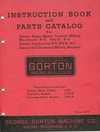Technical manuals
Technical manuals for Mills
All manuals are available in html form and also as .pdf (always named "manual.pdf")
- Model 8D, 8 1/2D, 9-J Mills
There is also a Lubrication diagram
for these mills.





- 9-J Vertical Mill
As of 1950, the 9-J was the largest mill, with a cross travel of 12",
longitudinal travel of 24", vertical capacity of 17 1/2", and a ram
with travel up to 12 1/4". It came with a No. 10 B & S spindle, but
could alternatively be fitted with a No. 4 Morse or No. 40 American Standard.
The manual is available in a couple of additional formats:
- MasterMil 1-22
The MasterMil was introduced in the 1950s as a slightly less premium model,
with a correspondingly lower price. This version of the maintenance manual is from
1958 or later. It also had a double of page 49/50, but no page 47/48.
The operator's manual is from April, 1967 or later.


- 1-22 Trace-Master
This is an adaptation of the 1-22 MasterMil, fitted with a hydraulic tracer unit. The
manual is from the post-Kearny & Trecker acquisition timeframe.

- Twin Spindle, T-Ram
This manual was in the same booklet as the 1-22 Trace-Master, and one of the pictures shows
a 1-22 outfitted with a hydraulic tracer unit and dual spindles.
Also from Kearney & Trecker era.

- 2-30 Mill
This size 2 vertical mill is believed to have first been made during
the mid-1960s; two separate manuals are provided - the operators manual and
the maintenance/parts manual, along with a schematic of the drive.




- 2-30 Auto Trace Master
A combined maintenance and parts manual for this machine.
The manual is from the Kearney & Trecker era, which roughly dates it
to 1968-1975 (no copyright date is listed)

- Technical report about 2-30 TapeMaster
The Western Electric Company did a technical study of a 2-30 TapeMaster in 1969

Technical manuals for Pantographs
- Pantographs
Multiple versions of the pantograph manuals are available.
At present, the 1945 (form 1385-D) version is the only one which has been converted
to additional documentation formats beyond html and pdf.
Office 97 format (6.8Mb), and
Open Office format (6.8Mb).
They do not cover the operation of P1-* or P2-* series machines.






The last page of the 1942 (1385-C) manual has an interesting
edict
from the War Production Board regarding the minimal
use of primer and paint; the default must be "old machine tool gray"
- P1-2 Pantomill, 1960s
This is likely from the 1960's, based upon the style of the logo.

- P1-3 Ratiobar Pantograph Manual, 1948
This
is a typewritten manual specifically for the (then new) P13 pantograph, and
is specifically titled as a supplement to the 1945 Pantograph manual (Form 1385-D)

- Signature Engravers (1936)
The Model 3E and 3Q signature engravers were portable models, for personalizing
various small items, such as penknives, pens, combs, etc.

Manuals for other products
- 16-B Swiss Automatic Screw Machine
With the demand for Swiss Automatic machines growing, coupled with the
curtailing of shipping such machines from Europe, Gorton Machine licensed
the rights to manufacture the Petermann P-7. The initial model,
the 16-A, is a copy of the P-7, with a redesigned base and variable speed
controls. After some study, Gorton [the company] felt that the machine
could be improved upon in a number of ways. This improved model, the 16-B,
was completed June 30, 1944.


- Spitfire Electric Arch Etcher

This was a special head for the various pantographs. Sort of an early
air-cooled EDM (electrical discharge machining) device.
The instructions for this are hand transcribed.
- Grinding Instructions for Model 265 Cutter Grinder
Instructions for the operation of a model 265 cutter grinder, with
either the number 276 or number 333 tool heads are here in:

Copyright, @@COPYRIGHT_DATES@@ Richard Gorton - @@CONTACT_INFO@@
Please contact me if you wish to use images or content herein



























